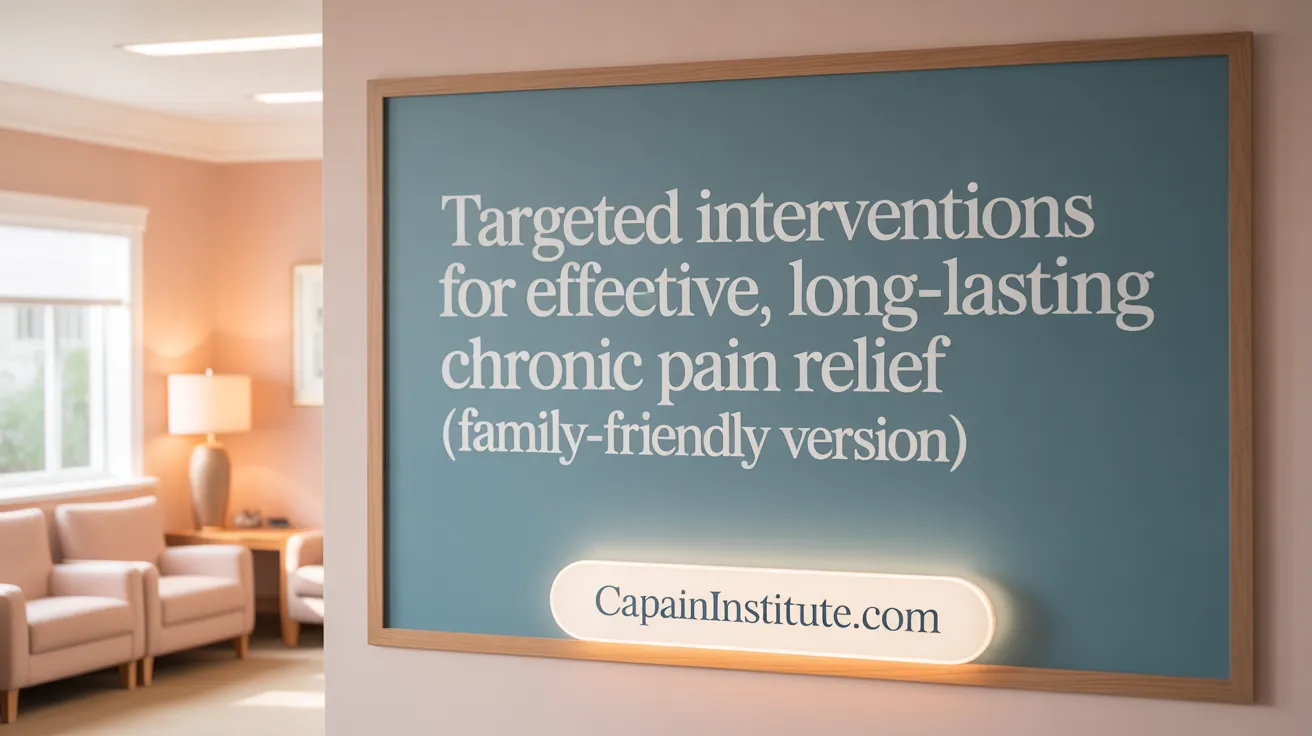Understanding Interventional Pain Procedures and Their Importance in Recovery
Chronic pain management has undergone significant transformation with the advent of interventional pain procedures. These minimally invasive techniques are designed to target the root causes of pain, offering patients targeted relief that goes beyond symptom masking. This article explores the various methods, benefits, safety considerations, and long-term impacts of interventional pain treatments, highlighting their emerging role in facilitating long-term recovery and improving quality of life for those suffering from persistent pain conditions.
<!-- VIDEO:eyJsaW5rIjoiaHR0cHM6Ly93d3cueW91dHViZS5jb20vd2F0Y2g/dj00SHJPV1JqLXVESSIsImltYWdlVXJsIjoiZGF0YTppbWFnZS9qcGVnO2Jhc2U2NCwvOWovNEFBUVNrWkpSZ0FCQVFBQUFRQUJBQUQvMndDRUFBa0dCd2dIQmdrSUJ3Z0tDZ2tMRFJZUERRd01EUnNVRlJBV0lCMGlJaUFkSHg4a0tEUXNKQ1l4Sng4ZkxUMHRNVFUzT2pvNkl5cy9SRDg0UXpRNU9qY0JDZ29LRFF3TkdnOFBHamNsSHlVM056YzNOemMzTnpjM056YzNOemMzTnpjM056YzNOemMzTnpjM056YzNOemMzTnpjM056YzNOemMzTnpjM056YzNOLy9BQUJFSUFGTUFsQU1CSWdBQ0VRRURFUUgveEFBYUFBQUNBd0VCQUFBQUFBQUFBQUFBQUFBQUJBRUNCUU1HLzhRQVBSQUFBZ0VEQWdRQ0NBTUdCQWNBQUFBQUFRSURBQVFSRWlFRkV6RkJJbEVHRkRKaGNZR1JvVE5Ta2hVamdySEI4RUp5MGZFSEpEUkRVMkxoLzhRQUdnRUFBZ01CQVFBQUFBQUFBQUFBQUFBQUFBSUJBd1FGQnYvRUFEUVJBQUVEQVFRSEJ3TUVBd0FBQUFBQUFBRUFBZ01SQkFVU1VTRXhRWkdoMGVFVEZCVVdJbUh3TWxKeFUyS0I4VE5DUS8vYUFBd0RBUUFDRVFNUkFEOEFmOWV0ODdzLzZLRGZRRTdPdy9ncXZCa3RaVTRoNjFhaVl3Mmp6b1RJeTRLbFJqWWo4MzJyZEhvL1pMY1dtdTNibHpYVU1mNHAzVm9DemQ4anhEK3hUT3NFTFRRazhPUzVFVjdXNlZ1SnVIY1ZpZXZRRHE3Zm9vOWV0L3p0K2ltZUZjT2h1T0szOE54WUlERkFYUzM1N0JRdzA0OGVyUGZ6NzA1THdiaDZSMzZKRXhZU1hRaWRuYk1mS1FFYmQ5ejNvTmhnQnBVOE9TbGw2Vzk0cU1PNHJMOWV0OGUwL3dDbW9GOUIzZHovQUFWb2poTnFPSzhSdDRyVG5yQmFwSkZDMHJMbGpvems1QjdudlhEZ1BEYlM3dGRWekNXZWE2YTNVaHlPV0JFejVHT3B5QjFvN2hEU3RUdzVLUEZyZmlEZlR0MkhZbHZYN2Y4QU0zNmFnMzBCNk00L2dxL0VyS0tDRGhKanRRaTNGdkRKSk56U1M3TUJxR25PMzBGYTcrajFrelR2RkdkTU4xY0l5Y3h2dzFqSlU5ZXphZmpuZWcyR0FmN0hoeVV0dlM4SEVnQnVqMkt4R3ZyYzRHdHRqdjRLbjE2M0I5cDhlV2l0V0xodGpNaXREd3hYay9acVhJajlZa0FaMllER1MzUURQMXE4SEIrSGVvOFBtbnRTQk1MYlU0bWJ4dEl6S3dJejRRQUFjN1ZCc01JMnU0Y2t3dk8zblZoM0ZZNXZyZnM3Zm9vRjlCM2RqL0JXbXZCYmVHMHVGOVQ5WnU0TFdLUWhwbVFGbWtZRTdFZEZBMnE4bkE3S0MwZ3V6RHpZNVV0QnBNakREdm5XTmo1RlRSM0dETThPU2p4TzhQMjdpc24xNjM3dStQOEFKVSt2VytQYWY5RmFrZkIrSFMza29GdVVqanZwNHRBa1k2a2ppREFaSnp1ZC9uWGEzOUhySzZsSmppSUhNdEg1Zk1iMkhHWFViL0UrZTFIY29CdGR3NUpoZVY0SFZoM0ZZZ3ZvTTd1eC9ocWZYN2Y4emZvcDFlRVdoNFhaVGNzOCtTK1ZaZkdmd1dka0E2K2E5ZXRZZC9Fc04vZFJSakNSek9pak9jQU1RS1p0M3d1MU9QRGtzOHQ5VzZJQXVEZHg1cDQzMXY4QW5iOUJxR3ZiY2dEVzNYOGxaZ283MC9oa1gzSGh5VlBtRzE1TjNIbXRVWDF1T2pQK2lpc3Vpand5TDdqdzVJOHcydkp1NDgxM3RMeGJOYnNGYytzV3pRWnpqVGtxYy9hdFpQU1ZSY3hTbTIvRG5qbUk1blVKRVk4ZE8rYzVxZlJTY1d5OFFuYTVOc3NhUXMwb1VuQTVxNUdBTTdqYjUxcWxCTHdXMWtpaVpZZjJqSGRJMm5Bdzg3cUI5Q3UxYW5rWXRJV1d6eHlkbUMxMU50S1pGZVp0dUlRV3N0NTZ2RTNLdUlERXF2SUNWMVlPU1FCbm9lMVB6K2theUxlNXRzU1ROSzBaNW40WWtVSzJSamZwdDByZmFPS1N4dkdKQW5pYmlETDcweVEzM0tVdHdDS09iZ1BEbVlmOUpkU1hSL3lwblAzMDBwYzBpcEN0YkRNMXdZMStzVjFmTTFqemNjczVyaTVsZXptLzV1M0VNcWljZHRPQ3ZoMjluMzlhNGNKNHluRHJab3VUekNKVFBDM014cFlvVThXMjR3ZmRYb09JUVNIaEhHMEVURlpidWFjeVkyWGx5UmdENWpWOURUOS9ib2VJMmtsdUMycmlUU3VvM3c2UkhQMTBBL09qRzJsS0p1N3pZc1dMU1BiTS9DdkRYVjh0eExaT0UwaTJ0NG9mYTlyUnRuNTFwbjBuUHJFcnh4QlJJODVkZVoxRWdBeDhpb05ieUpMSGVYWWowd3ZjM3lsbGtVNGNOYmxpckFkc2svTVZ4NGRkTEZ4RGdoZTVka2o0WUpEQVZPbGYzYmVMT2VwK0hhZ3ZhUnFTdGdsWTc2NlZPWHZSWUtjYWc1WEp1TGRtajlSanRHQ1NoVDRXenFHUWZwVlpPT0EyUXQwaUNrUVc4UWN2bmVObVlINTZ2dFhxa3QxNGRGWVdhdVl6Ykc2RE91NVVtTXNEOGd3cFRoNGpsOUhtbUU1bHVJNHIxMWxZWVoxT3hQeHlWTkdKdXVpa3dTajBsK21tWDQ1ckh1L1NDRGlFL0VXbnRHNU42c1M2WTVRQ21nNTY0UFUrNnF2eDkydGhiOG45MkRic0JxNk5FTUU5TytCOE1WVDBsdUpwNTdJenl2SWZVWVc4Unp1VUJKK1pySHpWcldOTFFhTEZMUEt5UXR4Y1BtYTNJdlNEbHp2TDZ0a1BlVFhETHIvd3lKcEs1eDFIblY0L1NWNGJsWm9iY3FzY3NUS3BmUGdSQ21rN2JraGp2OXFyRjZQeHlJakc5VUZsVWtjczdaUFQ1VWh4U3dXdzVPbWNTaVFFK3lSakJyRkhickhMSjJiVHBYUWtzbDVRUjlvNGFCK0ZvTDZRNGdTRDFST1dnaTNCR29za212T3JHY0hjWTdaTlpYRVo0Ym05bG5naWVOWldMbFhjTWRSSkozd05xMExJMlhFYklXY25MdHJtRlNZNU1iU2ZFL3ovQUxGWTVCQktucURXeVBEVWlsQ3NGcDdRc2E0bXJUd09TRDFvb29xNVlsTkZSVTBJVFVjZDVGRk5FaUVKTUFzaTVYeEFISSs0cnVseHhWVlZWWmdGalNOUjRjQlZiVW8rb3pUUzlXUHZveGx3QU8xY0Ezak5ySUc3cXZiTnVDRWFudTM5RXExeHhVa2tzMi9OQjluL0FMbnQvV29nbDRwQkNJWWk2eGhXWFNOUFJpQ2Z1b3A3a3ZqcDM2VlVxVUFEQTV6VmJiMGM0MEJiOC9sTjVmaUduRzdmMFNzbHp4YVFzWkdZNmxrVWp3N2h6bHZyVW03NHdUSXhkc3lPenZzdTVaZEJQNmRxWUlIWGVvMk9WcXp2ODJRM2RWSGdVWDZqdC9SY29iN2pNQUhLa1lZVkZHUWh3RkdCMTc0MnoxeFZEYzhWTWNVZmFLSXhJZEtaQ0VhY1o2blltbU5zNmNWSUdkajhpS08veTVEZDFSNEhGK283ZjBYRVgzR2VielRJek9HTFpLb2VxaFR0L2xBRmN6TnhNalNNcXVtUmRLaEFNU2UyTWUvRk5LZkZnZk0wRGRtUHlvNy9BRFpEZDFRYmlpUC9BRWR2NkxPbmp2YmxrYVpTeklpeHI3SXdxakFIMHBkb1pWSlV4U0VqWTRVbkgwclpJOFNnZkUwbExkUXgzQUVnbThFcFk2WTJJSUs0OHEwV2UyeVBkUjFBUG51dWRlRnlzaGo3U1BFNDErYkYwajRweGRGUUxKT0ZHbFZKak9OanR2akhXbHVIeW0rNDNJT0thcFdqamJTa200eU9neDlUaW5aT0tXYldhV2xwRmNScUpBVlV4RUtvem5GS1hLY1FIRVZUaExtT1NkTXVRQjBYdnVQZU9sYzYzdFpvd05BL0M3bHdDWDFtVXV5RmNscDhXaWpXYUdKclZIajBuZVB3T21QSTlDTi9LdWR4d2k4dXpBbG5FYnB0UGhjWVZ0STdNTytOdC9sNVYya2tzb2I3blNTdmRYUlFSbGQ5S2ZMb04rb3JWOUgrS3cyZkZIbnZYWUswWlVFRE9OeHRqNVVXTzJTQWhvT2dKcnd1cUNiRTQ2emwvUzg4dm8xeDVpd1BEVzhQVUxLcEkrSXpTUHFkeUQrRWZxSzlud2U0c2VGM2J6QzdEL3UyakJTQmxhVExsdFRuTzdmNms5OERBMXJ6Q29JSjdqeXJlKzhKYWVtaTVubCt6RjMxR256MldYNm5jZjhBaVAxRlRXdFJWZmlNL3R1NnB2TGxtKzUzRGtxN2FzWng1a21uMTRUTy9DZlg1V2FPS1FnUVJqWnBCK1pqMUE4Z0tSV01UVHd3TVNGbm1qaGI0TTRCK3hOZTk5S1luL1pRNVEvZHhzQzRYYkM0SS9xS3l4UkIxWHUwMDFjMTFabmwwZ2lybzJyd3QxNlB4dGI4MUpSSEo3V3lBL3pIOWFlc3VGVFhYQm12TE5TMHNKS3pXMmNpUUFaMUpuY0gvd0JlbndyZ1piWXFJZVkvS0xFRERmNHR2ZjhBSGF2VmVoRU1rZkRwWkdETEZMTG1NRTlnTUgrL2RWbUVTK21UU0ZNMExZbTRveGhQc3ZGRFRwQlJneU9OU05VQlQ1L0RQYW4rTXdyYmNWdjRFQTBKY1pVRHNHVU1mdVRTSnl2VGVzalFXMVlkaG9yMlB4c0Q4MVVrN2p2bXBjZFRrL0NwSjhxa0hyazA2WlZHRkFBT08rTVVNUUQ1RStWU056dmpQV2h0aURuRkNsR01ISk9hbU1NejZRQ1MzVEhlcTR5cEErVk4yMXhIRENTRi9mOEFYVmpZRHkvcnQvdElTa3JnU0FBVk9yT1I1Ymp1UE1lLzNINDF6dFk1NHBMdTdRb2RFSmpoenRoaWUvMEZXZHRiRmkyL2V1MGpjdTFTSlJ2SWRiZkR0L3JTUzBkb0NlRXVZS2sxS3lWU1NCMEVwMXN4MU13UGZ1VFRySFpzSHI5NlMxRjNaajNiN1UzQ1R5bCtGWWJMSU8xYzFvMEs2VUhDQ1ZMbVF5cXNhNml3ODhWWnJhU3lrYUtiQWRtWmowMjMyKzJLYXRPSFh0N0h6TFczZHdwSTFvQmtIYmJQOVBlYVhZT1pEeldKSTJHUmp2OEEvSzZ0UUdVb3NPRWwrS3FrWm9vb3FsWHFoTWlrUEYrTEd5eUpucHFVZ2o3aXZSOGEvd0NJbkJZTFF4QzN2YjJXU1B4d1JRSEM1RzRaanRuNFpOZWVKR3d5SzR0RElHYVMybU1NcmUweTdodmpXbXp5TVlhUDFMQmJJcGY4a0lxY3VTWVJQV1plU2wxWnhuQXpjUE9vMjl3N211SG81L3hDYmhQRWJpd3VySzhuNFR6ZE5yT2taTHhqQUJKQjZxVGx2TVoraXdUaXE2Z0xzWVk1YnhkZmp0WGFHRjlFYTNNM1BDWTBMakNyZ2JWcGMrelJOSmFjUldOczF2dERnMTBlRVpsTzNsdzEzY3ozVHFVTnpLWk5QY0RHRkh4d0JYSEdrakZRVG5JYjUxSUdTYzl0cTVvcnBKMW5TdXd4b1kwTkd4QThYWHlvS2pHQjlNMUJYSndEaWc0UHYyMnFVNkF1NDJ4aXBKSWIzVkFPM1g3MVppTVl6OHFFS3BiRGI5cXRxak1NZ2NxT2hCUHgvd0J2cFVBZVJIWE5WWlNZMlhwc2U5Q1B5cnJLaVJvcXh4eUZrMGduL0NjbmNlZXcrOWRMcVl6UHJPM2JhazBqZFhCOFBYZkh6eDhldE1LaGtrRVkzTEhHS1U1bE1RQm9hczJQMmEwN0Mya3VZMjVTZzh1TXlOdmpDaXV5OEh0aE1zSW1seUZ5K0NOdnRXcjZNalFMcGJlZU9GVnc3Q1JkUktEUGZ5MzZWaHNjRG15RnhWbG9kUm1oY09GL3RkYlp2MmROR2tXbzREY3YydHV1b1pySlpKTlpFMk9icThaR01hdStNYlVTYVdic1IyN1pxTTdIZmZIblhVZkppYUcwMUxESEJnZTU5ZGF2UlJSVmEwS01EcjNvd01aNzBVVUlSMm93S0tLRUtINlpvZmJHS0tLRkNGNzFEQUJ4UlJRaFF2dEdyRUFtaWloU3AwZzR6L09pcG9vUW9JR2FiNGFBYm9Fam9weFJSU1Ara3BtZlVGYXlZdEpjTVRrbU1uTkp4U3lSNmpHN0xxWFNjSEdSNVVVVU0xbFMvVUZRZ2ExOTlSanhZOTFSUlRxdGRhS0tLRksvLzlrPSIsInRpdGxlIjoiVGhlIFJvbGUgb2YgSW50ZXJ2ZW50aW9uYWwgUGFpbiBNYW5hZ2VtZW50Iiwic25pcHBldCI6Ii4uLiBwYWluIGlzIHVuZGVyIGNvbnRyb2wsIHlvdSBjYW4gc2VlIGRldmVsb3BtZW50cyBpbiBUQkkgcmVjb3ZlcnkgLi4uIEFuIEVTSSwgb3IgZXBpZHVyYWwgc3Rlcm9pZCBpbmplY3Rpb24sIGdpdmVzIG1lYW5pbmdmdWwgbG9uZy10ZXJtIHJlbGllZiB3aXRoIC4uLiJ9 -->Techniques and Applications of Interventional Pain Management

What are interventional pain management procedures and techniques?
Interventional pain management involves minimally invasive procedures designed to target the source of chronic pain directly. These techniques aim to reduce pain, improve mobility, and enhance overall quality of life.
Common procedures include nerve blocks, epidural injections, radiofrequency ablation, and spinal cord stimulation. Nerve blocks involve injecting anesthetic or steroid medications near specific nerves to block pain signals temporarily or long-term. Epidural injections, such as epidural steroid injections, deliver corticosteroids into the epidural space around the spinal cord, reducing inflammation and relieving nerve-related pain.
Radiofrequency ablation (RFA) uses heat generated by radio waves to disrupt nerve function, providing pain relief often lasting several months to over a year. Spinal cord stimulators are implanted devices that send electrical impulses to the spinal cord, interfering with pain signals and improving patient comfort.
In addition to these, newer techniques like epiduroscopy allow real-time visualization of the spinal canal, enabling precise, targeted interventions for lower back pain. These procedures are often guided by imaging technologies like fluoroscopy or ultrasound, which enhance accuracy and safety.
Treatment plans are highly personalized, considering individual patient conditions and pain locations. This tailored approach helps optimize outcomes, potentially avoiding or delaying the need for more invasive surgical procedures.
Overall, these minimally invasive interventions are designed not only to alleviate pain but also to reduce reliance on medications, especially opioids, and accelerate recovery. They form an integral part of comprehensive pain management strategies, often combined with physical therapy and psychological support to maximize benefits for patients with chronic pain conditions.
Role in Chronic Pain Management and Long-Term Recovery

What role do interventional pain procedures play in managing chronic pain?
Interventional pain procedures are vital tools for managing persistent, long-term pain. They offer targeted and minimally invasive options, such as nerve blocks, epidural injections, radiofrequency ablation, and spinal cord stimulation. These techniques help identify the specific sources of pain and treat them directly, providing relief without the need for open surgery. By focusing on the root cause of pain, these procedures can significantly reduce discomfort and improve patient mobility.
Additionally, interventional techniques can serve diagnostic purposes, helping physicians pinpoint exact pain generators. This precision allows for more effective, customized treatment plans. Overall, they form an essential component of comprehensive pain management, especially for patients who have not responded well to medication or physical therapy, helping to enhance quality of life and functional capacity.
How do interventional pain treatments contribute to long-term pain management and recovery?
Interventional pain therapies are not merely for immediate relief; they also promote sustained long-term benefits. Procedures like nerve blocks and radiofrequency ablation can provide pain relief lasting several months or even years. These interventions target the core issues, often halting the pain cycle and preventing condition progression.
They also help reduce reliance on opioids and other systemic medications, decreasing risks related to dependency, side effects, and tolerance. By alleviating pain effectively, patients can engage more fully in physical therapy, regain strength, and resume daily activities faster. In many cases, these procedures contribute to preventing chronic pain from becoming debilitating, supporting overall recovery and improving quality of life long after the treatment.
Enhancing Rehabilitation and Injury Recovery Through Interventional Techniques
Interventional pain procedures significantly contribute to rehabilitation and injury recovery by providing minimally invasive, targeted treatments that reduce pain and inflammation, thereby improving mobility and tissue healing. Techniques such as nerve blocks, corticosteroid injections, and hyaluronic acid injections help alleviate joint and soft tissue pain, enabling patients to engage more effectively in physical therapy and rehabilitation.
In trauma management, interventional radiology procedures like transarterial embolization and balloon occlusion help control hemorrhage, stabilize injuries, and preserve organ function. These interventions often result in shorter recovery times, less surgical morbidity, and a quicker return to daily activities or sports.
Specific procedures tailored for accident-related injuries include epidural steroid injections for spinal injuries, nerve blocks for nerve damage, and kyphoplasty for compression fractures caused by osteoporosis. These targeted treatments aim to relieve pain more efficiently and facilitate early mobilization.
The minimally invasive nature of these techniques means patients experience fewer complications, less tissue damage, and faster recovery periods. By reducing the physical burden of invasive surgeries, these procedures support early rehabilitation efforts—allowing individuals to regain mobility, strength, and function sooner.
Overall, interventional pain and radiology procedures are pivotal in promoting faster healing, lowering complication risks, and enhancing the effectiveness of physical therapy. This synergy accelerates the journey toward full recovery after injuries or surgeries, improving quality of life and enabling patients to return to their normal activities more rapidly.
Balancing Benefits, Risks, and Safety in Interventional Pain Management
 Interventional pain procedures have transformed the management of chronic pain by offering targeted relief and reducing the reliance on long-term medications, especially opioids. Techniques such as nerve blocks, epidural injections, and radiofrequency ablation directly address the source of pain, often resulting in significant improvements in patients' quality of life. For example, epidural steroid injections can effectively decrease inflammation and alleviate pain caused by degenerative spinal conditions, helping patients regain mobility.
Interventional pain procedures have transformed the management of chronic pain by offering targeted relief and reducing the reliance on long-term medications, especially opioids. Techniques such as nerve blocks, epidural injections, and radiofrequency ablation directly address the source of pain, often resulting in significant improvements in patients' quality of life. For example, epidural steroid injections can effectively decrease inflammation and alleviate pain caused by degenerative spinal conditions, helping patients regain mobility.
Despite their advantages, these procedures carry inherent risks. Common complications include infection, nerve injury, bleeding, allergic reactions, and, in rare cases, hardware-related issues. Serious adverse events like neurological damage or dural puncture, while infrequent, require careful attention and skilled execution.
Ensuring safety begins with proper patient selection. Not all individuals are suitable candidates; thorough evaluation by experienced clinicians is essential. Employing image guidance such as fluoroscopy or ultrasound during procedures improves accuracy and reduces risk.
Strict adherence to aseptic techniques and proper monitoring during and after interventions further minimizes complications. Safety protocols include informed consent discussions, use of trained personnel, and preparedness to manage adverse events promptly.
To optimize outcomes, clinicians implement strategies such as meticulous planning, employing advanced imaging technologies, and maintaining rigorous infection control practices. These measures help realize the full potential of interventional pain procedures as safe, effective alternatives for complex pain management.
Long-Term Outcomes and the Broader Impact on Health and Opioid Use

How do interventional pain procedures impact long-term health and quality of life?
Interventional pain procedures play a vital role in enhancing long-term health outcomes by delivering targeted relief for chronic pain when traditional treatments are ineffective. These minimally invasive techniques—such as nerve blocks, epidural injections, and spinal cord stimulation—help improve mobility, reduce discomfort, and restore daily functions. Although all medical procedures carry some risks, including minor complications or, rarely, more serious adverse events, proper technique and patient selection generally ensure safety.
The recent COVID-19 pandemic underscored the importance of timely interventions; delays in receiving procedures often led to prolonged suffering and decline in quality of life. When integrated into comprehensive pain management programs, these procedures not only address physical pain but also support mental health and emotional well-being. Combined with supportive therapies like physical therapy and psychological counseling, they foster better long-term health and lessen the burden of chronic pain.
| Impact Area | Description | Additional Insight |
|---|---|---|
| Pain Relief | Targeted interventions reduce persistent pain | Improves mobility and daily activities |
| Mental Well-being | Supporting emotional health through relief | Enhances overall life satisfaction |
| Complication Risks | Potential adverse events, generally manageable | Emphasizes the importance of skilled care |
| Enhanced Management | Combines procedures with supportive therapies | Promotes comprehensive recovery |
Overall, interventional pain procedures are crucial for achieving sustained improvements, preventing long-term complications, and improving overall health.
How do interventional pain management techniques contribute to reducing opioid dependency?
Interventional approaches are instrumental in reducing reliance on opioids by providing effective, drug-free options to manage chronic pain. Procedures like nerve blocks, epidural injections, and nerve ablation target the source of pain directly, often alleviating symptoms without the need for prolonged medication use.
Implementing multimodal pain strategies—including physical therapy, patient education, and alternative therapies—further supports opioid tapering efforts. Evidence indicates that patients receiving these interventional treatments can cut their opioid intake by over half while maintaining or even improving pain control.
This shift not only minimizes the risks associated with long-term opioid use—such as dependence, overdose, and side effects—but also fosters safer, more sustainable pain management practices. Ultimately, interventional treatments serve as a cornerstone in efforts to reduce opioid dependency and promote safer pain relief options.
What are the long-term outcomes and recovery strategies involving interventional pain procedures?
Long-term success with interventional pain management hinges on appropriate patient selection, meticulous procedural techniques, and vigilant postoperative care. Many procedures—particularly nerve blocks and spinal cord stimulators—offer relief that can last for months or even years, significantly improving quality of life.
Recovery strategies focus on a holistic approach: careful monitoring for complications such as infections or nerve injuries, adherence to activity guidelines, and ongoing physical and psychological support. Combining invasive procedures with physical therapy enhances strength and mobility, solidifying gains from initial interventions.
Post-procedure, patients are encouraged to follow tailored rehabilitation programs, continue lifestyle modifications, and attend regular follow-ups. These strategies help maximize the benefits of interventional treatments, prevent recurrence, and support ongoing healing.
| Key Aspects | Description | Examples |
|---|---|---|
| Patient Selection | Identifying suitable candidates for procedures | Evaluation, imaging studies |
| Technique and Safety | Ensuring procedures are performed properly and safely | Skilled practitioners, image guidance |
| Monitoring and Follow-up | Ongoing assessment for complications and progress | Regular check-ups, imaging |
| Supportive Therapies | Combining with physical and mental health strategies | Physical therapy, counseling |
Through careful planning, comprehensive care, and monitoring, interventional procedures can achieve meaningful long-term relief and improved mobility, forming an essential part of effective chronic pain management.
The Future of Pain Management: A Focus on Integrated Interventional Approaches
Interventional pain procedures have become indispensable in the landscape of long-term pain management and recovery. By directly targeting the sources of pain through minimally invasive techniques, these procedures not only provide effective and sustained relief but also improve patients' quality of life, reduce dependency on opioids, and facilitate faster rehabilitation. While mindful of potential risks and the need for stringent safety measures, healthcare providers continue to refine these approaches within comprehensive, patient-centered care models. As research and technology advance, interventional pain management is poised to remain a cornerstone of multidisciplinary strategies aimed at transforming chronic pain care and supporting recovery over the long term.
References
- A comprehensive overview and scope of interventional pain ...
- Understanding interventional pain management: a guide for people ...
- Interventional Pain Management After Accidents: Relief and Recovery
- Interventional Pain Procedures: A Narrative Review Focusing On ...
- Recovering from Auto Accidents with Interventional Pain Medicine
- Interventional Pain Management | Birmingham, AL | Southside
- Interventional Pain Management: A Targeted Approach to Healing
- 6 Effective Benefits of Interventional Pain Management
- The Pain Crisis: Interventional Radiology's Role in Pain Management
